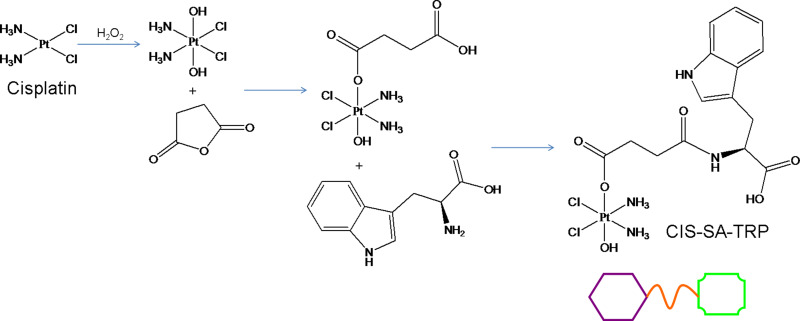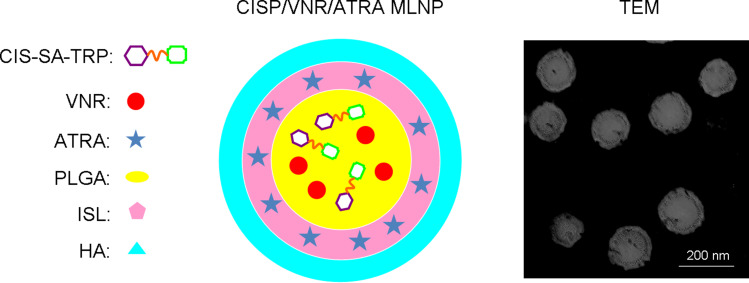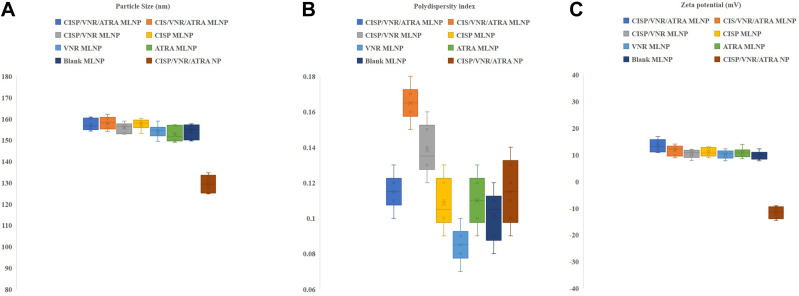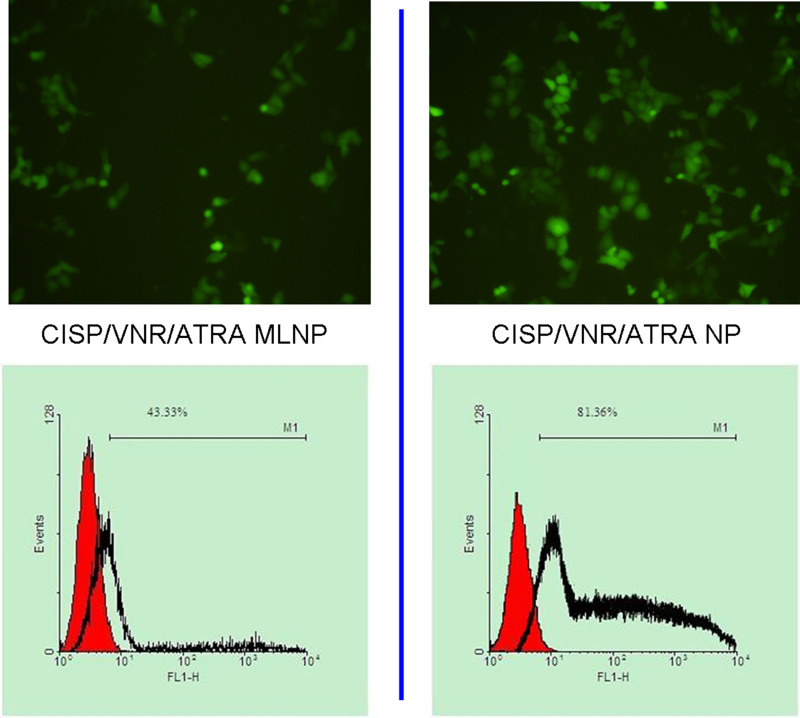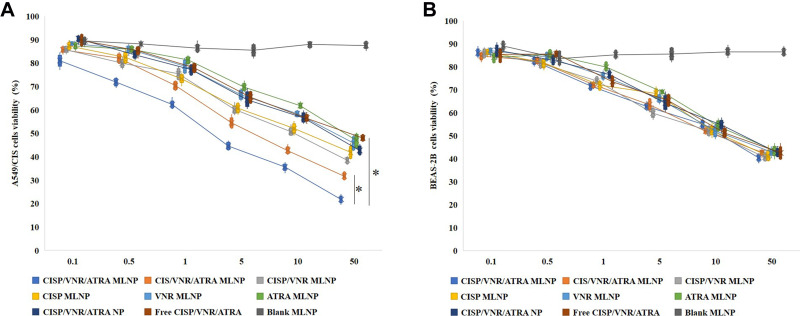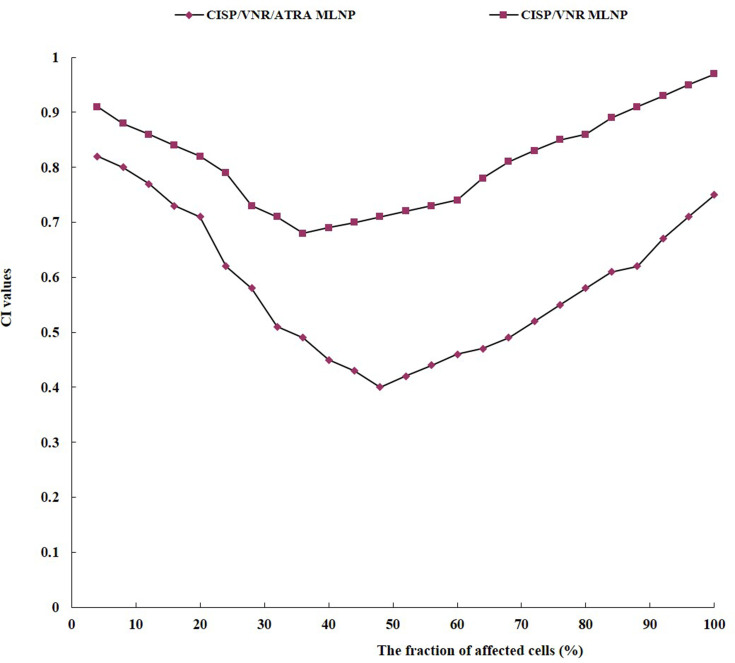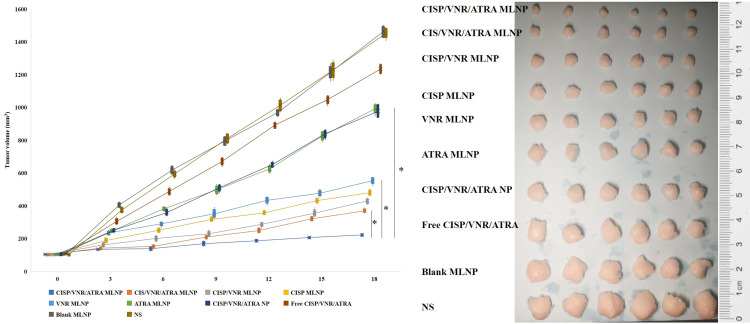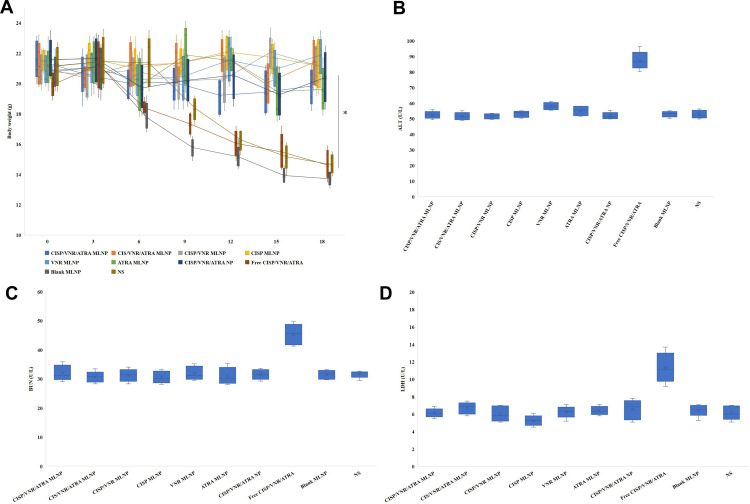Abstract
Purpose
Lung cancer remains the leading cancer-associated deaths worldwide. Cisplatin (CIS) was often used in combination with other drugs for the treatment of non-small cell lung cancer (NSCLC). Prodrug is an effective strategy to improve the efficiency of drugs and reduce the toxicity. The aim of this study was to prepare and characterize CIS prodrug, vinorelbine (VNR), and all-trans retinoic acid (ATRA) co-delivered multi-layered nano-platform, evaluating their antitumor activity in vitro and in vivo.
Methods
Cisplatin prodrug (CISP) was synthesized. A multi-layered nano-platform contained CISP, VNR and ATRA were prepared and named CISP/VNR/ATRA MLNP. The physicochemical properties of CISP/VNR/ATRA MLNP were investigated. In vitro cytotoxicity against CIS-resistant NSCLC cells (A549/CIS cells) and Human normal lung epithelial cells (BEAS-2B cells) was investigated, and in vivo anti-tumor efficiency was evaluated on mice bearing A549/CIS cells xenografts.
Results
CISP/VNR/ATRA MLNP were spherical particles with particle size and zeta potential of 158 nm and 12.3 mV. CISP/VNR/ATRA MLNP (81.36%) was uptake by cancer cells in vitro. CISP/VNR/ATRA MLNP could significantly inhibit the in vivo antitumor growth and suspended the tumor volume from 1440 mm3 to 220 mm3.
Conclusion
It could be concluded that the CISP/VNR/ATRA MLNP may be used as a promising system for lung cancer combination treatment.
Keywords: lung cancer, combination treatment, synergistic effect, cisplatin prodrug, multi-layered nano-platform
Introduction
Lung cancer is the leading cause of cancer death worldwide.1 In 2019, one-quarter of all cancer deaths are due to lung cancer in the USA.2 There are only 18% of all patients with lung cancer live 5 years or more after diagnosis.3 Non-Small Cell Lung Cancer (NSCLC), the most common type of lung cancer, accounts for more than 84%.2,4 Based on the NCCN Guidelines, surgery, radiotherapy, and systemic therapy are the three modalities most commonly used therapeutic regimens for NSCLC patients. Among them, chemotherapy is recommended for patients with stage IV (advanced) NSCLC and preoperative or postoperative chemotherapy for patients with NSCLC at stage IB-IIIA, and all aforementioned patients account for about 80% of NSCLC cases.4–7
Platinum-based chemotherapy (cisplatin, carboplatin, and their combination regimens) is recommended and beneficial for patients with stage IV NSCLC and preoperative and postoperative therapy in the NCCN guidelines.8–10 The main mechanism of antitumor effect for cisplatin (CIS) is to form CIS-genomic DNA interstrand and intrastrand cross-links, and hinder transcription and/or DNA replication, then lead to cell death. However, it is severe for the adverse reactions of CIS including nephrotoxicity, myelosuppression, and some patients are not able to tolerate it.11,12 Therefore, various researchers have devoted to new strategies to overcome these obstacles, including producing CIS prodrug, using nanotechnology, applying combination therapy, etc.13–15 The current standard combination chemotherapy of most patients with NSCLC remains platinum-based strategy containing vinorelbine (VNR), gemcitabine, paclitaxel, docetaxel, and pemetrexed.16
Combinations of two or more therapeutic agents or strategies have been explored for its unique advantages, such as improved drug efficacy, reduced adverse reactions, and multidrug resistance.17,18 All-trans retinoic acid (ATRA), the biological active metabolites of vitamin A, has been proven to have anticancer activity including lung cancer, leukemias, head/neck cancer, etc.19–22 Recent studies have investigated combination therapy of ATRA and CIS for lung cancer; results have shown that the combination brings enhancing therapeutic efficacy, and decreasing nephrotoxicity and drug resistance.23–25 However, the low water solubility of ATRA hinders its clinical application.
Nanocarriers have emerged as platforms for cancer therapy, because they can offer advantages over free drugs including improved intracellular penetration, enhanced distribution of drugs into a selected tissue, extended circulating half-life and long shelf life.26 Multi-layered nanoparticle platforms have been applied for combination drugs delivery to tumors.27,28 In this study, a novel CIS prodrug (CISP) was synthesized and a multi-layered nano-platform was constructed for the delivery of CISP, VNR, and ATRA. In vitro and in vivo performances were evaluated, summarized, and discussed.
Materials and Methods
Materials
Poly (D, L-lactic-co-glycolic) (PLGA, 50:50, MW 10,000) was provided by Beijing TopScience Bio-technology Co., Ltd (Beijing, China). Carbopol 940 (CBP, MW 1000,000) was obtained from Shanghai Renmin Pharmaceutical Factory (Beijing, China). Injectable soya lecithin (ISL) was obtained from Nanjing Well Pharmaceutical Co., Ltd (Beijing, China). Hyaluronic acid (HA, 300 kDa) was kindly provided by Bloomage Biotechnology Co., Ltd (Jinan, China). CIS, VNR, ATRA, EDC·HCl, NHS, dimethyldioctadecylammoniumbromide (DDAB) were obtained from Sigma-Aldrich China (Shanghai, China). Dulbecco’s modified eagle’s medium (DMEM), fetal bovine serum (FBS), and 3-(4,5-dimethyl-2-thiazolyl)-2,5-diphenyl-2-H-tetrazolium bromide (MTT) were purchased from Invitrogen Corporation (Carlsbad, CA).
Synthesis of Cisplatin Prodrug
Cisplatin prodrug (CISP) was synthesized by conjugating the amino group of tryptophan (TRP) with the carboxylated CIS (Figure 1).29 Briefly, H2O2 was added into CIS (300 mg, dissolved with DMSO) to form CIS-(OH)2, in which succinic anhydride (SA, 100 mg) was added and stirred for 10 h to obtain CIS-(COOH)2 (CIS-SA). EDC·HCl (50 mg) and NHS (30 mg) were dissolved in CIS-SA with stirring, in which TRP (50 mg, dissolved in water) was added and stirred for 24 h. Finally, the solution was dialyzed against water for another 24 h and lyophilized to obtain CISP (CIS-SA-TRP). ESI-MS m/z calculated for [C15H22Cl2N4O6Pt]+: 619.06 [M + H]+; found: 619.37. 1H-NMR analysis (DMSO-d6, 300 mHz, ppm): peaks at 2.03 belong to CIS, the signals attributed to TRP are at 3.06, 7.18, and 10.08, the formation of carboxy and amino groups was confirmed by the peaks at 2.65, 2.41, and 4.85, respectively.
Figure 1.
Synthesis of cisplatin prodrug. Cisplatin prodrug (CISP) was synthesized by conjugating the amino group of tryptophan (TRP) with the carboxylated CIS.
Preparation of Multi-Layered Nano-Platform
A multi-layered nano-platform contained CISP, VNR, and ATRA were prepared and named CISP/VNR/ATRA MLNP (Figure 2). Firstly, CISP and VNR loaded inner core was constructed by a solvent displacement technique.30 Briefly, CISP (20 mg), VNR (20 mg), and PLGA (100 mg) was dissolved in acetone (5 mL) and added drop-wise into 20 mL of water (contained 1% CBP, w/v) which was stirred (300 rpm) at room temperature for 6 h to form solution-1. Secondly, lipid mixed with ATRA as the middle layer was produced by a nanoprecipitation technique.31 Briefly, ATRA (20 mg), ISL (100 mg), and DDAB (1%, w/v) were dissolved in acetone (5 mL), then added dropwise to the solution-1 which was stirred (400 rpm) at room temperature for 6 h to get solution-2. Finally, positively charged HA (the surface layer) was coated onto the negatively charged middle layer.32 HA (100 mg) was dissolved in water and added to solution-2 which was stirred (400 rpm) at room temperature for 4 h to produce CISP/VNR/ATRA MLNP.
Figure 2.
A multi-layered nano-platform contained CISP, VNR and ATRA were prepared and named CISP/VNR/ATRA MLNP. The TEM image showed that the CISP/VNR/ATRA MLNP was spherical particles with inner cores and coats on the outer surface.
A multi-layered nano-platform contained CIS (not prodrug), VNR and ATRA were prepared by the similar method using CIS instead of CISP, named CIS/VNR/ATRA MLNP. A multi-layered nano-platform contained CISP and VNR was prepared and by the similar method without using ATRA, named CISP/VNR MLNP. Multi-layered nano-platforms contained single CISP, VNR or ATRA were prepared and by the similar method using CISP, VNR or ATRA only (without other drugs), named CISP MLNP, VNR MLNP, or ATRA MLNP. Blank multi-layered nano-platform was prepared and by the similar method without using any drugs, named Blank MLNP. A nano-platform contained CISP, VNR and ATRA but do not contain HA was prepared by the similar method without using HA as the outer layer, named CISP/VNR/ATRA NP. HA CISP, VNR and ATRA mixed solution were prepared by dissolving the three drugs in water (contained 1% Pluronic F68, w/v), named Free CISP/VNR/ATRA.
Characterization of Multi-Layered Nano-Platform
The morphology of the CISP/VNR/ATRA MLNP was observed by transmission electron microscopy (TEM) using an H-7650 transmission electron microscope (Hitachi, Tokyo, Japan).33 Average particle size, polydispersity index (PDI) and zeta potential of all the MLNPs were determined by dynamic light scattering using a Zetasizer Nano ZS90 (Malvern Instruments, Malvern, U.K.).34
Drug Encapsulation and Loading Efficiency
Drugs were isolated from the MLNPs were measured by redispersed the formulations in 0.1% Tween 80 and centrifuged (20,000 rpm, 15 min) and the supernatant was collected.35 The CIS content in MLNPs was determined by atomic absorption spectroscopy.13 The VNR and ATRA content were determined using HPLC at 269 nm and 340 nm.35,36 The drug encapsulation efficiency (EE) and loading efficiency (LE) of drugs loaded MLNPs were calculated by equations: EE (%) = The amount of drugs encapsulated in MLNPs/Total amount of drugs added×100%; LE (%) = The amount of drugs encapsulated in MLNPs/The amount of MLNPs×100%.
Serum Stability
The serum stability of MLNPs was evaluated in PBS mixed with FBS (1:1, v/v).37 MLNP formulations were incubated with 50% FBS (v/v) solution for 72 h. At 1, 2, 4, 8, 24, 48, and 72 h, 1 mL of formulation was taken out and the particle size and PDI were measured by the same methods described in the “Characterization of multi-layered nano-platform” section.
In Vitro Drug Release
The release study was conducted using a dialysis method.38 Briefly, MLNP formulations (2 mL each) were sealed into separate dialysis bags, which were immersed into PBS mixed with FBS (1:1, v/v) solutions (48 mL each, 37°C) under shaking (100 rpm). Aliquots (2 mL) were taken out from the solution periodically, and the amount of drugs released from MLNP was analyzed by the same methods described in the “Drug encapsulation and loading efficiency” section.
Cells
The CIS-resistant NSCLC cells (A549/CIS cells) and Human normal lung epithelial cells (BEAS-2B cells) were obtained from American Type Culture Collection (ATCC, Manassas, VA, USA) and cultured (37°C, 5% CO2) in DMEM medium (10% FBS, 100 U/mL penicillin, 0.1 mg/mL streptomycin).
Cellular Uptake
The uptake MLNP by A549/CIS cells was tested using coumarin 6 (C6) as an indicator.39 Briefly, C6 (40 mg) was dissolved along with PLGA (in acetone) in the preparation section. C6 contained CISP/VNR/ATRA MLNP and CISP/VNR/ATRA NP were added to A549/CIS cells which were previously incubated in a 24-well plate (1 × 105 cells/well, 24 h). The medium containing the formulations was discarded and the cells were washed three times with D-Hank’s solution and photographed by fluorescence microscopy. To quantify the uptake efficiency, cells were analyzed by a flow cytometer (BD Biosciences, San Jose, CA).
Cytotoxicity
The cytotoxicity of MLNP was evaluated on A549/CIS and BEAS-2B cells by MTT assay.40 Briefly, all kinds of MLNPs, CISP/VNR/ATRA NP and Free CISP/VNR/ATRA at different concentrations were added to A549/CIS or BEAS-2B cells which were previously incubated in 96-well plates (3 × 104 cells/well, 24 h). After removal of the medium, MTT solution (20 µL, 5 mg/mL in PBS) was added to each well. DMSO (200 µL) was added 4 h later and the absorbance at 570 nm was recorded.
Synergistic Effect
The synergistic effect of CISP/VNR/ATRA MLNP was evaluated by Chou-Talalay method.41 Combination index (CI) is applied for the evaluation of synergy or antagonism, which is calculated by the equation: CI =  .42 (C)i: the concentrations of drugs in the combination; (Cx)i: the concentrations of drugs used alone. CI < 1 indicated synergy, closer to zero means higher synergy efficiency; CI > 1 represented antagonism.
.42 (C)i: the concentrations of drugs in the combination; (Cx)i: the concentrations of drugs used alone. CI < 1 indicated synergy, closer to zero means higher synergy efficiency; CI > 1 represented antagonism.
Animals
BALB/c nude mice (6–8 weeks) were purchased from Beijing Vital River Laboratory Animal Technology Co., Ltd (Beijing, China) and the mice are maintained and treated in compliance with the guidance of the National Institutes of Health for the care and use of laboratory animals (NIH Publications No. 8023, revised 1978) and approved by the Animal Care and Use Committee of Peking University Cancer Hospital & Institute. A549/CIS cells (1×107) were injected into the abdominal cavity of mice to produce NSCLC xenograft mice.
In Vivo Tumor Inhibition
NSCLC xenograft mice were randomized into 10 groups (6 mice/group). CISP/VNR/ATRA MLNP, CIS/VNR/ATRA MLNP, CISP/VNR MLNP, CISP MLNP, VNR MLNP, ATRA MLNP, CISP/VNR/ATRA NP, Free CISP/VNR/ATRA, Blank MLNP, and 0.9% normal saline (NS) was intravenously injected every 3 days at an equivalent dose of CISP, VNR, and/or ATRA (2 mg/kg).43 The tumor volumes (V) of mice were measured every 3 days and calculated by the equation: V = length × width2/2. The tumor inhibition efficiency (TRE) was evaluated by the equation: TIE (%) = (Tumor weight of the mice treated with NS group - Tumor weight of the mice treated with formulations/Tumor weight of the mice treated with NS group × 100. At the end of study (day 18), the macroscopic images of tumor tissues were presented.
In Vivo Tissue Distribution
After intravenously injected with CISP/VNR/ATRA MLNP, CIS/VNR/ATRA MLNP, CISP/VNR/ATRA NP, and Free CISP/VNR/ATRA as the “In vivo tumor inhibition” section, mice were sacrificed at 1 h and 48 h.44 Major tissues (tumor, lung, heart, kidney, liver, and spleen) were harvested, weighed, and dissolved in the concentrated nitric acid by heating up and evaporated to dryness, and then re-dissolved in 0.1 N HCl for tissue distribution analysis by the same methods described in the “Drug encapsulation and loading efficiency” section.
Systemic Toxicity
The systemic toxicity of the formulations were evaluated by the changes of body weights and the variations of alanine aminotransferase (ALT), lactate dehydrogenase (LDH), and blood urea nitrogen (BUN).45 The body weights of mice were measured every 3 days and recorded. At the end of the study, blood was collected and centrifuged to obtain the serum. ALT, LDH, and BUN levels were assayed as indicators of renal and hepatic function.
Statistical Analysis
The non-parametric data were analyzed using Friedman test (n=6). *P < 0.05 was considered statistically significant.
Results
Characterization of Multi-Layered Nano-Platform
The TEM image showed that the CISP/VNR/ATRA MLNP was spherical particles with inner cores and coats on the outer surface (Figure 2). Particle sizes, PDIs, and zeta potentials were summarized (Figure 3). The size, PDI, and zeta potential of CISP/VNR/ATRA MLNP were about 158 nm, 0.11, and 12.3 mV. Similar results were found in other MLNPs, which illustrated the loading of drugs did not change the size and surface charge of the particles. The size of CISP/VNR/ATRA NP (127 nm) was smaller than CISP/VNR/ATRA MLNP, with a reversed surface charge (−13.5 mV). The EE and LE of drugs loaded MLNP were around 90% and 5%, respectively (Figure 4). The sizes and PDIs of MLNPs remained unchanged during the serum stability test, indicating the MLNPs may be stable in the plasma when administrated in vivo.
Figure 3.
Particle sizes (A), PDIs (B), and zeta potentials (C) of the particles.
Figure 4.
The EE (A) and LE (B) of drugs loaded particles.
In Vitro Drug Release
All the three drugs showed sustained release from MLNPs. CISP and VNR exhibited similar release profiles, showing complete release at 48 h (Figure 5). However, ATRA were released from MLNPs in different manners compared with CISP and VNR. Faster release was observed by ATRA, it took 36 h to totally release from MLNPs. CISP/VNR/ATRA MLNP showed slower drug release than that of non-HA coating CISP/VNR/ATRA NP.
Figure 5.
In vitro drug release profiles of CISP (A), VNR (B) and ATRA (C). All the three drugs showed sustained release from MLNPs. CISP and VNR exhibited similar release profiles, but ATRA were released from MLNPs in different manners compared with CISP and VNR.
Cellular Uptake
The cellular uptake efficiency of CISP/VNR/ATRA MLNP and non-HA coating CISP/VNR/ATRA NP was compared by the images and quantitative results (Figure 6). The result clearly showed that more CISP/VNR/ATRA MLNP (81.36%) were uptake by cancer cells in comparison with CISP/VNR/ATRA NP (43.33%) (P < 0.01). Remarkably higher uptake efficiency may be explained by the HA coating that improved the uptake of the particles, which was going to be discussed later.
Figure 6.
The cellular uptake efficiency of CISP/VNR/ATRA MLNP and non HA coating CISP/VNR/ATRA NP were compared by the images and quantitative results.
Synergistic Cytotoxicity
Concentration deepened manners were found in all drugs contained formulations on both A549/CIS and BEAS-2B cells (Figure 7). On A549/CIS cells, CISP/VNR/ATRA MLNP exhibited higher cytotoxicity than CIS/VNR/ATRA MLNP and CISP/VNR/ATRA NP (P < 0.05), while no significant difference was found on BEAS-2B cells. The cell viability was more remarkably inhibited by drugs loaded MLNPs and CISP/VNR/ATRA NP formulations than Free CISP/VNR/ATRA on A549/CIS cells (P < 0.01). However, BEAS-2B cells viability differences among the formulas were not that obvious. The synergistic cytotoxicity was evaluated by CI values on the bases of IC50 values of different formulations. The effect of three-drug combination treatment was compared with the effect of treatment with each drug alone. Figure 8 shows the CI values were <1 when the fraction of affected cells at the intervals of 20%-80%. CI values closer to 0 means higher synergy effects. More remarkable combination effect was exhibited by CISP/VNR/ATRA MLNP than that of CISP/VNR MLNP, indicating the better efficiency brought by ATRA.
Figure 7.
In vitro cytotoxicity. Concentration deepened manners were found in all drugs contained formulations on both A549/CIS (A) and BEAS-2B cells (B). *P < 0.05.
Figure 8.
The synergistic cytotoxicity was evaluated by CI values on the bases of IC50 values of different formulations. The effect of three-drug combination treatment was compared with the effect of treatment with each drug alone.
In Vivo Tumor Inhibition
In vivo tumor inhibition ability of CISP/VNR/ATRA MLNP was better than CISP/VNR/ATRA NP (P < 0.01), which could be the evidence of the tumor-targeted ability of the multi-layered nano-platform with an HA coat (Figure 9). CISP/VNR/ATRA MLNP also exhibited higher tumor inhibition efficiency than double drugs and single drug-loaded MLNPs (P < 0.01), this may attribute to the synergy effects of the three agents. Compare CISP/VNR/ATRA MLNP with CIS/VNR/ATRA MLNP, more significant antitumor efficacy was found by prodrug-based CISP/VNR/ATRA MLNP (P < 0.05). Drugs loaded nanoparticles illustrated stronger in vivo tumor inhibition effects than Free CISP/VNR/ATRA (P < 0.05).
Figure 9.
In vivo tumor inhibition ability of CISP/VNR/ATRA MLNP, CISP/VNR/ATRA NP and Free CISP/VNR/ATRA. *P < 0.05.
In Vivo Tissue Distribution
Higher tumor accumulation was found on MLNP formulations in comparison with CISP/VNR/ATRA NP and Free CISP/VNR/ATRA (Figure 10) (P < 0.05). In the meantime, drugs distribution in kidney and heart was lower for MLNP and CISP/VNR/ATRA NP formulations than the Free CISP/VNR/ATRA (P < 0.05). These results may influence the systemic toxicity of these systems when delivered in vivo.
Figure 10.
In vivo tissue distribution of CISP/VNR/ATRA MLNP, CISP/VNR/ATRA NP and Free CISP/VNR/ATRA. *P < 0.05.
Systemic Toxicity
No significant change of body weight was found on drugs loaded nanoparticles groups (Figure 11A). However, free CISP/VNR/ATRA exhibited obvious body weight lost, which may indicate the systemic toxicity. ALT, LDH, and BUN levels illustrated that drug-loaded nanoparticle groups did not change the parameters compared with control groups, while free drugs caused significant increase of these data (Figure 11B–D) (P < 0.05).
Figure 11.
Drugs loaded nanoparticles groups presented no significant change of body weight (A). ALT (B), LDH (C), and BUN (D) levels illustrated that drugs loaded nanoparticles groups did not change the parameters compared with control groups, while free drugs caused significant increase of these data. *P < 0.05.
Discussion
In this study, CIS prodrug (CISP) was synthesized and used as an antitumor agent, which was loaded in a multi-layered nano-platform. CIS prodrugs were widely used to overcome the main problems that limit the clinical use of cisplatin include acquired resistance and serious side effects such as neurotoxicity and nephrotoxicity, what is closely related to the lack of tumor selectivity of cisplatin.46 Examples included that Ling et al, produced a cisplatin conjugated 1.2-distearoyl-snglycero-3-phosphoethanolamine-N-mPEG3000 to reverse cisplatin resistance in ovarian cancer.47 As the start of the research, a CIS prodrug: CIS-SA-TRP was synthesized using an amino acid: tryptophan. Tryptophan is the precursor of serotonin, an important neurotransmitter, and one of the essential amino acids in human body.48 It could be used as nutrition supplements and anticonvulsant. As a tranquilizer, it can regulate mental rhythm and improve sleep.49 Tryptophan was used to produce CIS prodrug here and the in vivo effects will be discussed later.
A multi-layered nano-platform CISP/VNR/ATRA MLNP was constructed by CISP and VNR loaded polymeric core, ATRA contained middle layer, and HA-coated outer layer. TEM image of CISP/VNR/ATRA MLNP was spherical particles with inner cores and coats on the outer surface. The size and zeta potential of CISP/VNR/ATRA MLNP and other MLNPs are similar, which illustrated the loading of drugs did not change the size and surface charge of the particles.50 CISP/VNR/ATRA NP showed a smaller size and reversed negative surface charge than CISP/VNR/ATRA MLNP, indicating the HA coating enlarged the size and bring negative surface charge.34 HA is reported to prevent unnecessary protein adsorption and opsonization in the blood stream and also has targeting ability to the CD44 overexpressing cancer cell line.51,52 The sizes and PDIs of MLNPs remained unchanged during the serum stability test, indicating the MLNPs may have good stability when administrated in vivo. This was in accordance with the founding of Li et al, who concluded that no significant size changes means the proteins in the serum did not adsorb on the nanoparticles and did not cause aggregation, thus leading to increase in particle size.37
The sustained release of drugs from nanocarriers may be due to homogenous entrapment of the drugs, and the anticancer drugs could maintain continuous efficiency.53 In the section, drugs showed sustained release from MLNPs. Faster release was observed by ATRA when compared with CISP and VNR, this may be explained by the different position of drugs in the multi-layered carriers. CISP and VNR are encapsulated in the inner core, while ATRA are loaded in the middle layer. The depth of drugs loaded in the system can affect the release behavior.54 Drugs in the outer layers may release more quickly than the inner layers. So the effective and specific release manner of drugs in the presence of serum suggests that this multi-layered nano-platform may be more effective as an anti-tumor agent with sustained release and excellent stability in the blood.55
The cellular uptake efficiency of CISP/VNR/ATRA MLNP and non-HA coating CISP/VNR/ATRA NP was evaluated on A549/CIS cells, which have been reported to overexpress CD44 receptors on cell surface.56 Remarkably higher uptake efficiency of CISP/VNR/ATRA than CISP/VNR/ATRA NP. This phenomenon clearly demonstrates the role of HA-CD44 interaction in terms of enhancing cellular uptake.57 HA-coated multi-layered nano-platform may penetrate high overexpressed CD44 cells (A549 cells) through a receptor-mediated endocytosis.57 The penetration of drugs can be improved by HA surface layer thus could reduce the drug dose, attenuate side effect, and overcome drug resistance.58
Combination therapy using nanocarriers containing CIS has received much interest in cancer therapy to overcome CIS-resistant.59 For example, Cheng et al developed a CIS and Curcumin co-loaded liposomal delivery system to deliver into hepatocellular carcinoma cells.60 CIS and Curcumin co-encapsulated lipid-polymer hybrid nanoparticles were prepared by Li et al which showed and higher cytotoxicity than free drugs.61 Our study evaluated three agents encapsulated in one multi-layered nano-platform. The cell viability was more remarkably inhibited by CIS/VNR/ATRA MLNP than CISP/VNR/ATRA NP on A549/CIS cells but not BEAS-2B cells. These were in line with the cellular uptake results that HA-coated multi-layered nano-platform may penetrate high overexpressed CD44 cells (A549 cells) and exhibited more prominent cytotoxicity. To further determine the synergistic cytotoxicity, CI values were evaluated by on the bases of IC50 values of different formulations. More remarkable combination effect was exhibited by CISP/VNR/ATRA MLNP than that of CISP/VNR MLNP, indicating the better efficiency brought by ATRA.62
In vivo tumor inhibition ability of CISP/VNR/ATRA MLNP was better tumor than CISP/VNR/ATRA NP, which suggests the multi-layered nano-platform with an HA coat may increase the stability and the concentration of drugs in the blood and tumor.63 The results were summarized by Liu L et al that multi-layered nano-platform can also promote the apoptosis of lung cancer cells in vivo, thereby promoting subsequent apoptotic signaling and cell apoptosis, which is consistent with that in vitro.64 The in vivo distribution of drugs loaded in MLNPs followed the order: tumor > liver > lung > spleen > kidney > heart, which is in accordance with the conclusion drawn by Liu J et al.65 They argued that these results were attributed to the efficient accumulation of MLNPs in the tumors through HA targeting to the CD44 receptor. Body weight, ALT, LDH, and BUN parameters of MLNPs remained stable, which could be the evidence of the side effects were successfully alleviated.45 Our future study will devote to the application of this nano-platform from bench to bedside. Our group has devoted to the design and evaluation of these nano-platforms, which will be eventually used to treat cancer patients.
Conclusion
A multi-layered nano-platform CISP/VNR/ATRA MLNP was prepared. It has layered morphology with particle size and zeta potential of 158 nm, and 12.3 mV. As high as 81.36% of CISP/VNR/ATRA MLNP was uptake by cancer cells in vitro. CISP/VNR/ATRA MLNP could significantly inhibit the in vivo antitumor growth and suspended the tumor volume from 1440 mm3 to 220 mm3. CISP/VNR/ATRA MLNP may be used as a promising system for lung cancer combination treatment.
Disclosure
The authors report no conflicts of interest for this work.
References
- 1.GLOBOCAN. 2018. Available from: http://gco.iarc.fr/. accessed on 12April 2019.
- 2.Siegel RL, Miller KD, Jemal A. Cancer statistics, 2019. CA Cancer J Clin. 2019;69(1):7–34. doi: 10.3322/caac.21551 [DOI] [PubMed] [Google Scholar]
- 3.Noone AM, Howlader N, Krapcho M, et al. SEER Cancer Statistics Review, 1975-2015, National Cancer Institute. Bethesda, MD, https://seer.cancer.gov/csr/1975_2015/., November 2017. SEER data submission, posted to the SEER web site, April 2018.
- 4.Garbuzenko OB, Kuzmov A, Taratula O, Pine SR, Minko T. Strategy to enhance lung cancer treatment by five essential elements: inhalation delivery, nanotechnology, tumor-receptor targeting, chemo- and gene therapy. Theranostics. 2019;9(26):8362–8376. [DOI] [PMC free article] [PubMed] [Google Scholar]
- 5.Howington JA, Blum MG, Chang AC, Balekian AA, Murthy SC. Treatment of stage I and II non-small cell lung cancer: diagnosis and management of lung cancer, 3rd ed: american College of Chest Physicians evidence-based clinical practice guidelines. Chest. 2013;143(5Suppl):e278S–e313S. [DOI] [PubMed] [Google Scholar]
- 6.NSCLC Meta-analysis Collaborative Group. Preoperative chemotherapy for non-small-cell lung cancer: a systematic review and meta-analysis of individual participant data. Lancet. 2014;383(9928):1561–1571. [DOI] [PMC free article] [PubMed] [Google Scholar]
- 7.Masters GA, Temin S, Azzoli CG, et al. American Society of Clinical Oncology Clinical Practice. Systemic Therapy for Stage IV Non-Small-Cell Lung Cancer: american Society of Clinical Oncology Clinical Practice Guideline Update. J Clin Oncol. 2015;33(30):3488–3515. [DOI] [PMC free article] [PubMed] [Google Scholar]
- 8.Bradbury P, Sivajohanathan D, Chan A, Kulkarni S, Ung Y, Ellis PM. Postoperative Adjuvant Systemic Therapy in Completely Resected Non-Small-Cell Lung Cancer: A Systematic Review. Clin Lung Cancer. 2017;18(3):259–273.e8. [DOI] [PubMed] [Google Scholar]
- 9.Arriagada R, Bergman B, Dunant A, Le Chevalier T, Pignon JP, Vansteenkiste J. International Adjuvant Lung Cancer Trial Collaborative Group. Cisplatin-based adjuvant chemotherapy in patients with completely resected non-small-cell lung cancer. N Engl J Med. 2004;350(4):351–360. [DOI] [PubMed] [Google Scholar]
- 10.Socinski MA, Evans T, Gettinger S, et al. Treatment of stage IV non-small cell lung cancer: diagnosis and management of lung cancer, 3rd ed: american College of Chest Physicians evidence-based clinical practice guidelines. Chest. 2013;143(5):e341S–e368S. doi: 10.1378/chest.12-2361 [DOI] [PMC free article] [PubMed] [Google Scholar]
- 11.Campbell AB, Kalman SM, Jacobs C. Plasma platinum levels: relationship to cisplatin dose and nephrotoxicity. Cancer Treat Rep. 1983;67(2):169–172. [PubMed] [Google Scholar]
- 12.Matsui K, Masuda N, Uchida Y, et al. Determinants of myelosuppression in the treatment of non-small cell lung cancer with cisplatin-containing chemotherapy. Jpn J Cancer Res. 1996;87(7):781–786. doi: 10.1111/j.1349-7006.1996.tb00292.x [DOI] [PMC free article] [PubMed] [Google Scholar]
- 13.Li D, Cui R, Xu S, Liu Y. Synergism of cisplatin-oleanolic acid co-loaded hybrid nanoparticles on gastric carcinoma cells for enhanced apoptosis and reversed multidrug resistance. Drug Deliv. 2020;27(1):191–199. doi: 10.1080/10717544.2019.1710622 [DOI] [PMC free article] [PubMed] [Google Scholar] [Retracted]
- 14.Yang C, Tu K, Gao H, et al. The novel platinum(IV) prodrug with self-assembly property and structure-transformable character against triple-negative breast cancer. Biomaterials. 2020;232:119751. doi: 10.1016/j.biomaterials.2019.119751 [DOI] [PubMed] [Google Scholar]
- 15.Guo S, Wang Y, Miao L, Xu Z, Lin C-HM, Huang L. Turning a water and oil insoluble cisplatin derivative into a nanoparticle formulation for cancer therapy. Biomaterials. 2014;35(26):7647–7653. doi: 10.1016/j.biomaterials.2014.05.045 [DOI] [PMC free article] [PubMed] [Google Scholar]
- 16.Wang G, Wang Z, Li C, et al. RGD peptide-modified, paclitaxel prodrug-based, dual-drugs loaded, and redox-sensitive lipid-polymer nanoparticles for the enhanced lung cancer therapy. Biomed Pharmacother. 2018;106:275–284. doi: 10.1016/j.biopha.2018.06.137 [DOI] [PubMed] [Google Scholar]
- 17.Al-Attar T, Madihally SV. Recent advances in the combination delivery of drug for leukemia and other cancers. Expert Opin Drug Deliv. 2020;22:1–11. [DOI] [PubMed] [Google Scholar]
- 18.Gurunathan S, Kang MH, Qasim M, Kim JH. Nanoparticle-Mediated Combination Therapy: two-in-One Approach for Cancer. Int J Mol Sci. 2018;20(10):19. [DOI] [PMC free article] [PubMed] [Google Scholar]
- 19.Costantini L, Molinari R, Farinon B, Merendino N. Retinoic Acids in the Treatment of Most Lethal Solid Cancers. J Clin Med. 2020;9(2):28. doi: 10.3390/jcm9020360 [DOI] [PMC free article] [PubMed] [Google Scholar]
- 20.Zhang Y, Zhao J, Sun J, Huang L, Li Q. Targeting lung cancer initiating cells by all-trans retinoic acid-loaded lipid-PLGA nanoparticles with CD133 aptamers. Exp Ther Med. 2018;16(6):4639–4649. [DOI] [PMC free article] [PubMed] [Google Scholar]
- 21.Di Masi A, Leboffe L, De ME, Pagano F, Cicconi L. Retinoic acid receptors: from molecular mechanisms to cancer therapy. Mol Aspects Med. 2015;41:1–115. [DOI] [PubMed] [Google Scholar]
- 22.Quintero Barceinas RS, García-Regalado A, Aréchaga-Ocampo E, Villegas-Sepúlveda N. All-Trans Retinoic Acid Induces Proliferation, Survival, and Migration in A549 Lung Cancer Cells by Activating the ERK Signaling Pathway through a Transcription-Independent Mechanism. Biomed Res Int. 2015;2015:404368. [DOI] [PMC free article] [PubMed] [Google Scholar]
- 23.Yucel C, Erdogan Yucel E, Arslan FD, et al. All-trans retinoic acid prevents cisplatin-induced nephrotoxicity in rats. Naunyn Schmiedebergs Arch Pharmacol. 2019;392(2):159–164. [DOI] [PubMed] [Google Scholar]
- 24.Zhu YH, Ye N, Tang XF, et al. Synergistic Effect of Retinoic Acid Polymeric Micelles and Prodrug for the Pharmacodynamic Evaluation of Tumor Suppression. Front Pharmacol. 2019;10:447. [DOI] [PMC free article] [PubMed] [Google Scholar]
- 25.Peer D, Karp JM, Hong S, Farokhzad OC, Margalit R, Langer R. Nanocarriers as an emerging platform for cancer therapy. Nat Nanotechnol. 2007;2(12):751–760. [DOI] [PubMed] [Google Scholar]
- 26.Suh MS, Shen J, Kuhn LT, Burgess DJ. Layer-by-layer nanoparticle platform for cancer active targeting. Int J Pharm. 2017;517(1–2):58–66. [DOI] [PubMed] [Google Scholar]
- 27.Huang WT, Larsson M, Lee YC, Liu DM, Chiou GY. Dual drug-loaded biofunctionalized amphiphilic chitosan nanoparticles: enhanced synergy between cisplatin and demethoxycurcumin against multidrug-resistant stem-like lung cancer cells. Eur J Pharm Biopharm. 2016;109:165–173. [DOI] [PubMed] [Google Scholar]
- 28.Vergara D, Bellomo C, Zhang X, et al. Lapatinib/Paclitaxel polyelectrolyte nanocapsules for overcoming multidrug resistance in ovarian cancer. Nanomedicine. 2012;8(6):891–899. [DOI] [PubMed] [Google Scholar]
- 29.Zhou D, Xiao H, Meng F, et al. Layer-by-layer assembled polypeptide capsules for platinum-based pro-drug delivery. Bioconjug Chem. 2012;23(12):2335–2343. [DOI] [PubMed] [Google Scholar]
- 30.Tan S, Wang G. Lung cancer targeted therapy: folate and transferrin dual targeted, glutathione responsive nanocarriers for the delivery of cisplatin. Biomed Pharmacother. 2018;102:55–63. [DOI] [PubMed] [Google Scholar]
- 31.Yu W, Liu C, Liu Y, Zhang N, Xu W. Mannan-modified solid lipid nanoparticles for targeted gene delivery to alveolar macrophages. Pharm Res. 2010;27(8):1584–1596. [DOI] [PubMed] [Google Scholar]
- 32.Ramasamy T, Tran TH, Choi JY, et al. Layer-by-layer coated lipid-polymer hybrid nanoparticles designed for use in anticancer drug delivery. Carbohydr Polym. 2014;102:653–661. [DOI] [PubMed] [Google Scholar]
- 33.Zhang R, Ru Y, Gao Y, Li J, Mao S. Layer-by-layer nanoparticles co-loading gemcitabine and platinum (IV) prodrugs for synergistic combination therapy of lung cancer. Drug Des Devel Ther. 2017;11:2631–2642. [DOI] [PMC free article] [PubMed] [Google Scholar]
- 34.Yue Y, Zhao D, Yin Q. Hyaluronic acid modified nanostructured lipid carriers for transdermal bupivacaine delivery: in vitro and in vivo anesthesia evaluation. Biomed Pharmacother. 2018;98:813–820. [DOI] [PubMed] [Google Scholar]
- 35.Arantes VT, Faraco AAG, Ferreira FB, et al. Retinoic acid-loaded solid lipid nanoparticles surrounded by chitosan film support diabetic wound healing in in vivo study. Colloids Surf B Biointerfaces. 2019;188:110749. [DOI] [PubMed] [Google Scholar]
- 36.Gong Z, Chen M, Ren Q, Yue X, Dai Z. Fibronectin-targeted dual-acting micelles for combination therapy of metastatic breast cancer. Signal Transduct Target Ther. 2020;5:12. [DOI] [PMC free article] [PubMed] [Google Scholar]
- 37.Li S, Wang L, Li N, Liu Y, Su H. Combination lung cancer chemotherapy: design of a pH-sensitive transferrin-PEG-Hz-lipid conjugate for the co-delivery of docetaxel and baicalin. Biomed Pharmacother. 2017;95:548–555. [DOI] [PubMed] [Google Scholar]
- 38.Tan S, Wang G. Redox-responsive and pH-sensitive nanoparticles enhanced stability and anticancer ability of erlotinib to treat lung cancer in vivo. Drug Des Devel Ther. 2017;11:3519–3529. [DOI] [PMC free article] [PubMed] [Google Scholar]
- 39.Zhang Y, Zhang P, Zhu T. Ovarian carcinoma biological nanotherapy: comparison of the advantages and drawbacks of lipid, polymeric, and hybrid nanoparticles for cisplatin delivery. Biomed Pharmacother. 2019;109:475–483. [DOI] [PubMed] [Google Scholar]
- 40.Shao Y, Luo W, Guo Q, Li X, Zhang Q, Li J. In vitro and in vivo effect of hyaluronic acid modified, doxorubicin and gallic acid co-delivered lipid-polymeric hybrid nano-system for leukemia therapy. Drug Des Devel Ther. 2019;13:2043–2055. [DOI] [PMC free article] [PubMed] [Google Scholar]
- 41.Zhu QY, Scarborough A, Polsky B, Chou TC. Drug combinations and effect parameters of zidovudine, stavudine, and nevirapine in standardized drug-sensitive and resistant HIV type 1 strains. AIDS Res Hum Retroviruses. 1996;12(6):507–517. [DOI] [PubMed] [Google Scholar]
- 42.Chou TC. Drug combination studies and their synergy quantification using the Chou-Talalay method. Cancer Res. 2010;70(2):440–446. [DOI] [PubMed] [Google Scholar]
- 43.Wang H, Sun G, Zhang Z, Ou Y. Transcription activator, hyaluronic acid and tocopheryl succinate multi-functionalized novel lipid carriers encapsulating etoposide for lymphoma therapy. Biomed Pharmacother. 2017;91:241–250. [DOI] [PubMed] [Google Scholar]
- 44.Zhang Y, Yang C, Wang W, et al. Co-delivery of doxorubicin and curcumin by pH-sensitive prodrug nanoparticle for combination therapy of cancer. Sci Rep. 2016;6:21225. [DOI] [PMC free article] [PubMed] [Google Scholar]
- 45.Yang F, Li A, Liu H, Zhang H. Gastric cancer combination therapy: synthesis of a hyaluronic acid and cisplatin containing lipid prodrug coloaded with sorafenib in a nanoparticulate system to exhibit enhanced anticancer efficacy and reduced toxicity. Drug Des Devel Ther. 2018;12:3321–3333. [DOI] [PMC free article] [PubMed] [Google Scholar]
- 46.Lazarević T, Rilak A, Bugarčić ŽD. Platinum, palladium, gold and ruthenium complexes as anticancer agents: current clinical uses, cytotoxicity studies and future perspectives. Eur J Med Chem. 2017;142:8–31. [DOI] [PubMed] [Google Scholar]
- 47.Ling X, Tu J, Wang J, Shajii A, Kong N, Feng C, Zhang Y, Yu M, Xie T, Bharwani Z, Aljaeid BM, Shi B, Tao W, Farokhzad OC. Glutathione-Responsive Prodrug Nanoparticles for Effective Drug Delivery and Cancer Therapy. ACS Nano. 2019;13(1):357–370. [DOI] [PMC free article] [PubMed] [Google Scholar]
- 48.Situ AJ, Kang SM, Frey BB, An W, Kim C, Ulmer TS. Membrane Anchoring of α-Helical Proteins: role of Tryptophan. J Phys Chem B. 2018;122(3):1185–1194. [DOI] [PMC free article] [PubMed] [Google Scholar]
- 49.Sadok I, Gamian A, Staniszewska MM. Chromatographic analysis of tryptophan metabolites. J Sep Sci. 2017;40(15):3020–3045. [DOI] [PMC free article] [PubMed] [Google Scholar]
- 50.Duan W, Liu Y. Targeted and synergistic therapy for hepatocellular carcinoma: monosaccharide modified lipid nanoparticles for the co-delivery of doxorubicin and sorafenib. Drug Des Devel Ther. 2018;12:2149–2161. [DOI] [PMC free article] [PubMed] [Google Scholar]
- 51.Lee Y, Lee H, Kim YB, et al. Bioinspired Surface Immobilization of Hyaluronic Acid on Monodisperse Magnetite Nanocrystals for Targeted Cancer Imaging. Adv Mater. 2008;20(21):4154–4157. [DOI] [PMC free article] [PubMed] [Google Scholar]
- 52.Culty M, Shizari M, Thompson EW, Underhill CB. Binding and degradation of hyaluronan by human breast cancer cell lines expressing different forms of CD44: correlation with invasive potential. J Cell Physiol. 1994;160(2):275–286. [DOI] [PubMed] [Google Scholar]
- 53.Zhang G, Liu F, Jia E, Jia L, Zhang Y. Folate-modified, cisplatin-loaded lipid carriers for cervical cancer chemotherapy. Drug Deliv. 2016;23(4):1393–1397. [DOI] [PubMed] [Google Scholar]
- 54.Jeon S, Yoo CY, Park SN. Improved stability and skin permeability of sodium hyaluronate-chitosan multilayered liposomes by Layer-by-Layer electrostatic deposition for quercetin delivery. Colloids Surf B Biointerfaces. 2015;129:7–14. [DOI] [PubMed] [Google Scholar]
- 55.Zhang C, Pan D, Li J, et al. Enzyme-responsive peptide dendrimer-gemcitabine conjugate as a controlled-release drug delivery vehicle with enhanced antitumor efficacy. Acta Biomater. 2017;55:153–162. [DOI] [PubMed] [Google Scholar]
- 56.Kim M, Kim YS, Kim KM, et al. Combination of Sasa quelpaertensis Nakai leaf extract and cisplatin suppresses the cancer stemness and invasion of human lung cancer cells. Integr Cancer Ther. 2014;13(6):529–540. [DOI] [PubMed] [Google Scholar]
- 57.Tran TH, Choi JY, Ramasamy T, et al. Hyaluronic acid-coated solid lipid nanoparticles for targeted delivery of vorinostat to CD44 overexpressing cancer cells. Carbohydr Polym. 2014;114:407–415. [DOI] [PubMed] [Google Scholar]
- 58.Lu Z, Su J, Li Z, Zhan Y, Ye D. Hyaluronic acid-coated, prodrug-based nanostructured lipid carriers for enhanced pancreatic cancer therapy. Drug Dev Ind Pharm. 2017;43(1):160–170. [DOI] [PubMed] [Google Scholar]
- 59.Yuan YG, Gurunathan S. Combination of graphene oxide-silver nanoparticle nanocomposites and cisplatin enhances apoptosis and autophagy in human cervical cancer cells. Int J Nanomedicine. 2017;12:6537–6558. [DOI] [PMC free article] [PubMed] [Google Scholar]
- 60.Cheng Y, Zhao P, Wu S, et al. Cisplatin and curcumin co-loaded nano-liposomes for the treatment of hepatocellular carcinoma. Int J Pharm. 2018;545(1–2):261–273. [DOI] [PubMed] [Google Scholar]
- 61.Li C, Ge X, Wang L. Construction and comparison of different nanocarriers for co-delivery of cisplatin and curcumin: a synergistic combination nanotherapy for cervical cancer. Biomed Pharmacother. 2017;86:628–636. [DOI] [PubMed] [Google Scholar]
- 62.Liao H, Zhao S, Wang H, Liu Y, Zhang Y, Self-Assembly SG. Of Retinoid Nanoparticles For Melanoma Therapy. Int J Nanomedicine. 2019;14:7963–7973. [DOI] [PMC free article] [PubMed] [Google Scholar]
- 63.Xie F, Ding RL, He WF, Liu ZJ, Fu SZ, Wu JB, Yang LL, Lin S, Wen QL. In vivo antitumor effect of endostatin-loaded chitosan nanoparticles combined with paclitaxel on Lewis lung carcinoma. Drug Deliv. 2017;24(1):1410–1418. [DOI] [PMC free article] [PubMed] [Google Scholar]
- 64.Liu L, Dai H, Wu Y, et al. In vitro and in vivo mechanism of hepatocellular carcinoma inhibition by β-TCP nanoparticles. Int J Nanomedicine. 2019;14:3491–3502. [DOI] [PMC free article] [PubMed] [Google Scholar]
- 65.Liu J, Zhang D, Lian S, et al. Redox-responsive hyaluronic acid-functionalized graphene oxide nanosheets for targeted delivery of water-insoluble cancer drugs. Int J Nanomedicine. 2018;13:7457–7472. [DOI] [PMC free article] [PubMed] [Google Scholar]



